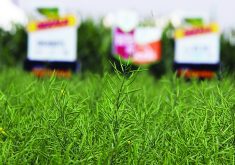One of canola’s fathers thinks farmers might need to force their neighbours to stop over-growing canola.
And a leading canola developer thinks canola’s future could be grim if endemic problems aren’t controlled.
“If we abuse it, we’re going to lose it,” Garth Hodges, Bayer CropScience vice-president of marketing and business development, told the Canola Council of Canada convention March 8, referring to the few clubroot-resistant genes that researchers know about.
He said short rotations are weakening the crop’s ability to withstand pressure from clubroot, blackleg, weeds, pests and other challenges.
Read Also

Farming Smarter receives financial boost from Alberta government for potato research
Farming Smarter near Lethbridge got a boost to its research equipment, thanks to the Alberta government’s increase in funding for research associations.
“How do we go back to some of the basics like saying we have to go into (good) crop rotation and be better at crop rotation?”
Keith Downey, one of the researchers who created canola, said he worries that the current three resistant genes “are not going to be enough,” and that new ones might not be found soon enough.
He suggested that existing legislation allowing municipalities to require adequate rotations could be used to stop some farmers from growing canola too often and creating the conditions for chronic clubroot infestation and other problems.
“I think that’s something that the people in this room have to take leadership of,” said Downey.
Municipal governments won’t push something controversial like that through unless worried farmers make it clear they need it to protect their farms.
“They’re never going to impose it unless the people that are growing the crop say, ‘yes, this is a good idea,’ ” said Downey.
Thousands of farmers have been tightening rotations in recent years and canola production with two-year rotations are becoming common in some areas. Some farmers have even grown canola on canola.
Generally agronomists frown upon anything less than a one-in-three year rotation with many advocating for one-in-four, which was a longtime standard.
The intensive canola production was in response to higher margins for canola than most other crops. However, it has occurred at the same time as clubroot has spread and become a major worry for growers everywhere.
A number of early resistant varieties began to fail after the disease adapted to the extensively grown varieties.
Hodges said he is concerned that many individual players in the canola industry understand the problem, but that collectively no one has yet taken control of it.
“There’s a time now where if we don’t get together and really focus on some of the basics of agronomy, I don’t know if we have canola to be able to be there,” said Hodges.
He said he might sound melodramatic, but the growing problems with many canola production challenges means the sustainability of the industry could be jeopardized.
“How do we get the industry to self-regulate itself?” said Hodges.
He said creative ways could reward farmers who follow good rotations, such as a crop insurance discount.
He compared minor moves in tackling issues like clubroot, such as switching between resistant varieties of canola, to a smoker facing lung cancer deciding to switch cigarette brands.
He said he was also concerned that some growers assume that the industrial giants such as his company will simply develop new varieties and products that minimize the problem.
“It’s hard to invent new chemistry,” said Hodges.
As a result, the industry needs to find a way to collectively push for better rotations. That’s a challenge in an industry of strong but independent players.
“Are we pointing to each other as to who is the one who is responsible for making it sustainable?” said Hodges.


















